 Pocket Informant 2005 is an integrated Pocket PC application that replaces the built-in Calendar, Contacts, Tasks, Notes, Journal programs and adds a Timeline view.
Pocket Informant 2005 is an integrated Pocket PC application that replaces the built-in Calendar, Contacts, Tasks, Notes, Journal programs and adds a Timeline view.
Loaded with customisation options, the program lets you dabble with just about everything and anything you can see on screen – typefaces, font sizes, font colours, categories, category colours, icons – the lot!
Although this seem a bit like overkill, the different screen sizes and resolutions available on PocketPCs means that controlling font sizing can come in very handy.
So, how does this do-it-all Personal Information Manager (PIM) shape up? Let’s take a closer look.
Calendar
The Calendar view offers a host of different views, displaying one day, seven day or whole month views on one screen, with the Agenda view presenting a user-selectable number of days of appointments in a list format, with the option to filter out ‘free’ days.
New appointments may be added by tapping and holding on a day’s title bar. Double-tapping on an entry opens its detail screen for viewing, editing or adding alarms.
Regularly recurring meetings can be set up as templates to speed up text entry (e.g. “Going to pub.”)
As soon as an event has passed it is displayed in italics, making it easy for the easily confused to see what events are remaining in the current day.
As with all the components in the Pocket Informant suite, a global navigation bar sits at the bottom of the screen, offering instant access to diary views, contacts, notes, to-dos and filter and search options.
 Contacts
Contacts
The Contacts screen opens up with a tabbed alphabetical row along the time allowing nifty access to contacts.
Inputting new contacts is straightforward enough, with the program auto-filling in frequently-entered text.
A whole host of fields are available to include every possible detail of your new contact, with the option to associate mugshots with contacts, and assign multiple categories.
The search facility is particularly clever, with users able to specify that the program looks for entries that start with the search text or for entries that contain the specified text.
Once a number is located, it can be dialled IR, Bluetooth, DTMF or Serial.
Naturally, there are options galore for listing contacts, including First/Last name, Last/First name, providing a picture list, and grouping by company, department, city, state, country, and category.
 Tasks
Tasks
As you might have guessed by now, the Tasks interface comes with a shedload of options, with entries being sorted/grouped by category, importance, priority, progress, completion, or date.
There’s the usual filtering and grouping options available, with users able to set up nested hierarchical tasks.
Tasks may be dropped on others to establish relationships, child tasks can be created by tapping and holding on a task and the hierarchical display may be expanded or collapsed.
Tasks can also be set to repeat with nagging reminders and start and completion dates entered.
 Notes
Notes
Here’s where we were very disappointed.
Unlike the simplicity of Palm’s ‘Memos’, the handling of notes is a real half arsed affair in Pocket Informant – the display is a real dog to get around, and everything seems needlessly complicated.
Sure, the improved text formatting is a nice touch, but finding, organising and categorising notes seems a needlessly tiresome chore.
I hope the Pocket Informant developers – who have a well earned reputation for listening to their punters – take a long hard look at how programs like Agendus on the Palm handle notes and learn from their experience.
Conclusion
Apart from the clunky horror of the Notes interface, it’s easy to see why Pocket Informant has become the most popular PIM application on the Pocket PC.
The program does an admirable job of making it easy for users to search find, organise and display content on the small screen of a Pocket PC and provides excellent value at $29.95 (~€24.5~£16.50).
With its extraordinary amount of user-configurable options, the program can be tailored to fit individual requirements, and with ample power under the hood, it can easily grow with the user’s needs.
Although the sheer range of options can confuse new users (us included), the intuitive, usable defaults make it easy to get started with the program.
Whether many users will ever get around to discovering the true power of the program is another matter, however.
We still think, however, that it’s the best PIM application available for the Pocket PC with only the poor support for Notes preventing it getting our very top rating.
Digital-Lifestyles score: 4/5

Price: $29.95 (~€24.50, ~£16.50)
Buy now online at PocketGear – Special Offer $22.95 until 30 Sep.05
Further information Pocket Informant
 Virgin’s ‘independent-style’ record label, V2 Music has teamed up with mobile video solutions developer Rok Player to announce the release of an ‘indie music video album’ for playing on mobile phones.
Virgin’s ‘independent-style’ record label, V2 Music has teamed up with mobile video solutions developer Rok Player to announce the release of an ‘indie music video album’ for playing on mobile phones. Using Rok Player technology, indie kids can play back audio-visual content preloaded on memory cards at an impressive 24 frames a second (full screen) on compatible mobile handsets.
Using Rok Player technology, indie kids can play back audio-visual content preloaded on memory cards at an impressive 24 frames a second (full screen) on compatible mobile handsets. “This is such an exciting development in the distribution of music videos” enthused Beth Appleton of V2 Music “as nearly everyone has, or will have, a compatible mobile phone and ROK Player turns those into portable DVD players. So now, for the first time, people can watch as well as listen to their favourite artists perform”.
“This is such an exciting development in the distribution of music videos” enthused Beth Appleton of V2 Music “as nearly everyone has, or will have, a compatible mobile phone and ROK Player turns those into portable DVD players. So now, for the first time, people can watch as well as listen to their favourite artists perform”. Bruce Renny of ROK , commented, “We’re already seeing tremendous interest in our music video albums for mobile phones, and to be able to include this new title in our portfolio is tremendous. We’re expecting the V2 album to prove very popular indeed because of the high quality of the artists it features”.
Bruce Renny of ROK , commented, “We’re already seeing tremendous interest in our music video albums for mobile phones, and to be able to include this new title in our portfolio is tremendous. We’re expecting the V2 album to prove very popular indeed because of the high quality of the artists it features”.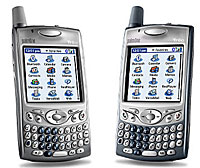 To the sound of a thousand wailing Palm Pilots, Palm has unveiled a version of the classic Treo smartphone running on Windows Mobile 5.0.
To the sound of a thousand wailing Palm Pilots, Palm has unveiled a version of the classic Treo smartphone running on Windows Mobile 5.0. Palm users still waiting for the Wi-Fi card categorically promised at the
Palm users still waiting for the Wi-Fi card categorically promised at the 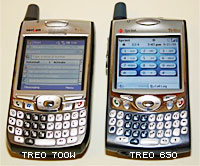 Carmi Levy, Senior Research Analyst at Info-Tech Research Group commented that the new Treo signals a massive shift in the handheld/smartphone market, adding that “when viewed in conjunction with the sale of PalmSource earlier this month, it’s an acceleration in the demise of the Palm OS platform and final confirmation that its once-dominant position in the broader handheld market is gone for good.
Carmi Levy, Senior Research Analyst at Info-Tech Research Group commented that the new Treo signals a massive shift in the handheld/smartphone market, adding that “when viewed in conjunction with the sale of PalmSource earlier this month, it’s an acceleration in the demise of the Palm OS platform and final confirmation that its once-dominant position in the broader handheld market is gone for good. There’s been no release date set for the Windows-based Treo yet, but it is expected to be available “very early” in 2006.
There’s been no release date set for the Windows-based Treo yet, but it is expected to be available “very early” in 2006. Pocket Informant 2005 is an integrated Pocket PC application that replaces the built-in Calendar, Contacts, Tasks, Notes, Journal programs and adds a Timeline view.
Pocket Informant 2005 is an integrated Pocket PC application that replaces the built-in Calendar, Contacts, Tasks, Notes, Journal programs and adds a Timeline view.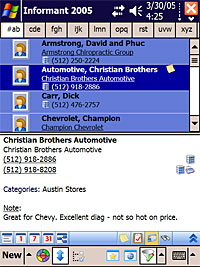 Contacts
Contacts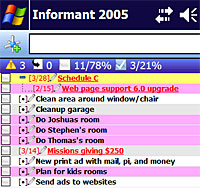 Tasks
Tasks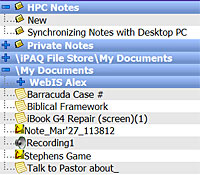 Notes
Notes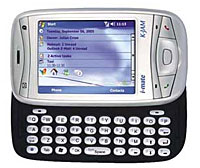 Building on the success of their hugely popular JAM phone, i-mate have announced the new K-JAM smartphone/PDA.
Building on the success of their hugely popular JAM phone, i-mate have announced the new K-JAM smartphone/PDA.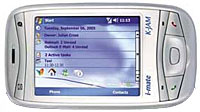 The display comes in the form of a 2.8″ QVGA (240 x 320 pixels) 64k Transflective screen, and the device runs on the latest Windows Mobile 5.0 OS.
The display comes in the form of a 2.8″ QVGA (240 x 320 pixels) 64k Transflective screen, and the device runs on the latest Windows Mobile 5.0 OS.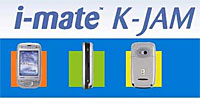 The phone offers support for a wide range of music formats, and claims 10 hours running time in PDA mode and 4-5 hours talk time.
The phone offers support for a wide range of music formats, and claims 10 hours running time in PDA mode and 4-5 hours talk time.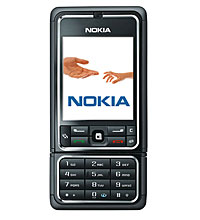 Finnish mobile giants Nokia have come up with the Nokia 3250, a new music-driven mobile phone featuring dedicated music keys and storage for up to 750 songs.
Finnish mobile giants Nokia have come up with the Nokia 3250, a new music-driven mobile phone featuring dedicated music keys and storage for up to 750 songs. Songs can be converted from CD and transferred from home PCs using the “drag and drop” Nokia Audio Manager software.
Songs can be converted from CD and transferred from home PCs using the “drag and drop” Nokia Audio Manager software.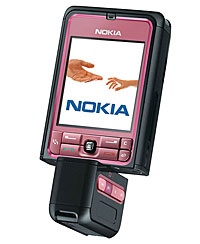 “Nokia connects people to their passions – music – and as the world’s largest manufacturer of digital music players, Nokia is leading the charge to make mobile music widely accessible. The XpressMusic feature brand, also introduced today, makes it easier for consumers to identify those Nokia devices which are specifically designed to listen to music,” purred Kai Öistämö, Senior Vice President, Mobile Phones, Nokia.
“Nokia connects people to their passions – music – and as the world’s largest manufacturer of digital music players, Nokia is leading the charge to make mobile music widely accessible. The XpressMusic feature brand, also introduced today, makes it easier for consumers to identify those Nokia devices which are specifically designed to listen to music,” purred Kai Öistämö, Senior Vice President, Mobile Phones, Nokia. An Australian production company has made what they are claiming is the first music video shot entirely with mobile-phone cameras.
An Australian production company has made what they are claiming is the first music video shot entirely with mobile-phone cameras.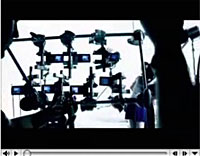 A multiplicity of mobiles (which look like Sony Ericsson k750i’s to us) were set up on frames and tripods with handheld footage recorded by four crew members who wandered around the band as they played, with the footage being sent via Bluetooth to laptops.
A multiplicity of mobiles (which look like Sony Ericsson k750i’s to us) were set up on frames and tripods with handheld footage recorded by four crew members who wandered around the band as they played, with the footage being sent via Bluetooth to laptops. The director of music video, Grant Marshall from Film Headquarters tries to explain, ‘We came up with this idea 18 months ago but couldn’t find a band that would embrace the risk and vision. P.U.S.A loved the concept and were brave enough to undertake the risk. This was a fantastic experience for all of us. The band was fabulous and incredibly professional.”
The director of music video, Grant Marshall from Film Headquarters tries to explain, ‘We came up with this idea 18 months ago but couldn’t find a band that would embrace the risk and vision. P.U.S.A loved the concept and were brave enough to undertake the risk. This was a fantastic experience for all of us. The band was fabulous and incredibly professional.” Verizon has launched an IPTV service in Keller, Texas delivered over their fiber-to-the-premises network.
Verizon has launched an IPTV service in Keller, Texas delivered over their fiber-to-the-premises network. Verizon are offers three set-top boxes: standard definition for $3.95/month; HD for $9.95/month; and a digital video recorder set-top box with HD channels for $12.95 permonth. Content packages between $13/month – $40/month are layer on top of this.
Verizon are offers three set-top boxes: standard definition for $3.95/month; HD for $9.95/month; and a digital video recorder set-top box with HD channels for $12.95 permonth. Content packages between $13/month – $40/month are layer on top of this. Following on from his review of the
Following on from his review of the 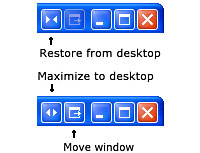 With support for more than ten monitors, UltraMon adds a raft of user-configurable tools to help users get a manly grip on their acres of screen real estate.
With support for more than ten monitors, UltraMon adds a raft of user-configurable tools to help users get a manly grip on their acres of screen real estate.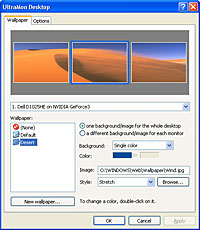 These little fellas let you quickly shunt programs across to other screens with a single click, or maximise a single window across the entire desktop.
These little fellas let you quickly shunt programs across to other screens with a single click, or maximise a single window across the entire desktop.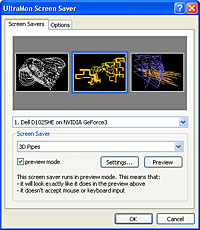 The program also lets you stretch desktop wallpapers and screen savers across multiple screens or set a different picture and screen saver for each screen, which can look way cool!
The program also lets you stretch desktop wallpapers and screen savers across multiple screens or set a different picture and screen saver for each screen, which can look way cool! Neat Idea!
Neat Idea! They’ve done it again
They’ve done it again It’s like the Middle Ages all over again!
It’s like the Middle Ages all over again!